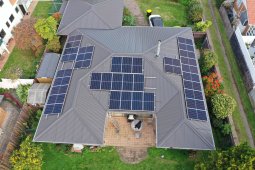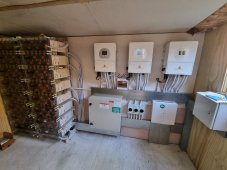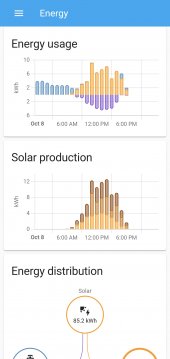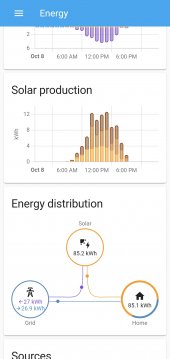Then, we gonna lough all day and all night.Just checked the Sungrow inverter tech sheet:
It can produce to the line 5kW BUT in backup mode it can only give 3kW.
Why? Donno. From its diagram it seems to be like other hybrid inverters.
Maybe they put in only a small DC/DC converter for the battery side.
And yes, just found it. Battery charge, discharge 65A/65A. That is 65A x 48V = 3kW
That is a joke
You are using an out of date browser. It may not display this or other websites correctly.
You should upgrade or use an alternative browser.
You should upgrade or use an alternative browser.
Choosing Equipment for Hybrid System
- Thread starter cods4
- Start date
mrzed001
Voice of reason
Then, we gonna lough all day and all night.
The Huawei fiasco comes into my mind about it.
Many bought it because "it is a hybrid" ... but in reality it is only a hybridized grid-tie.
So later they can connect a battery and a backup box to have a full working system in a blackout.
And ... no.
The 10kW 3phase inverter can only deliver 1 phase and 3kVA (really 2,5 kW) in a blackout.
Many are furious ...
Sungrow SH5K is a real hybrid. It has the potential to deliver the full power on-grid and off-grid.
But they gone cheap and put only a half sized DC/DC converter for the battery side.
![why-just-why[1].jpg why-just-why[1].jpg](https://diysolarforum.com/data/attachments/93/93532-510d7a51f9dbaef15ac399d47c6d35a8.jpg)
?
Well, given the fact it is a Hybrid system, not supposed to take all load in all possible scenario. So having a slightly smaller DC/DC converter make sense, and still have enough capacity in my case. In the other hand, I can't imagine a better component would make it lot more expensive, but I'm might be wrong. Anyway, this one was pretty much off the shelf, with all the rest what I wanted, so installation is next Thursday...
mrzed001
Voice of reason
Well, given the fact it is a Hybrid system, not supposed to take all load in all possible scenario. So having a slightly smaller DC/DC converter make sense, and still have enough capacity in my case. In the other hand, I can't imagine a better component would make it lot more expensive, but I'm might be wrong. Anyway, this one was pretty much off the shelf, with all the rest what I wanted, so installation is next Thursday...
The real question is: do you want to use it as an UPS?
If you have selected some equipment, made separate cabling to them, and you calculated its consumption (with inrush) ... then it is fine.
But if you want a house UPS system (excluded electric heating and electric cooktop) then you will have a problem.
Do not forget a real hybrid works as an UPS:
- You have 4kW load, power goes out (blackout, brownout), inverter switches to battery mode ... and shuts down with overload (can only give 3kW).
- Already blackout, battery mode, and you want to start a well pump. That has a high inrush ... and overload.
You have the point, however in our case it will be more then sufficient. The possibility for expansion is still there, if needed. Given the history of blackouts in the past 10 years, this investment would be way too expensive to eliminate the consequences of that (0). So I'd rather be happy with the power bill offset for now.
Quick update, the system is up and running, about for a month now. Creepy part of the year, so the result is pretty modest. Still looks promising. 7kWh on a cloudy day, 15kWh on a sunny day. I managed to capture most of it, however I already got a 24kWh Nissan Leaf battery pack to reconfigure and hook up to the inverter. Waiting for the Batrium monitoring system. Just to recap, 14x440W Jinko panels, NE facing roof (NZ), Sungrow SH5K-30 inverter.
My system is nearing completion. I ended up deciding on Deye hybrid inverters as the Victron multiplus is no longer approved here.
Panels are all installed. Inverters should be arriving in the next couple of weeks. DNO approval should come through soon.
So I will soon just need to book in the electrician to get it all up and running.
Panels are all installed. Inverters should be arriving in the next couple of weeks. DNO approval should come through soon.
So I will soon just need to book in the electrician to get it all up and running.
Attachments
mrzed001
Voice of reason
My system is nearing completion. I ended up deciding on Deye hybrid inverters as the Victron multiplus is no longer approved here.
Panels are all installed. Inverters should be arriving in the next couple of weeks. DNO approval should come through soon.
So I will soon just need to book in the electrician to get it all up and running.
Do you have any info why did they removed the Victron from the approved inverter list ?
I heard about it, but do not know the cause ...
I don't know for sure sorry, but I suspect it is that they are unable to fully support one of the new grid support modes such as Volt-VAr mode that the new standard requires.Do you have any info why did they removed the Victron from the approved inverter list ?
I heard about it, but do not know the cause ...
Hi, are you sure you posting in the right (DIY) forum?My system is nearing completion. I ended up deciding on Deye hybrid inverters as the Victron multiplus is no longer approved here.
Panels are all installed. Inverters should be arriving in the next couple of weeks. DNO approval should come through soon.
So I will soon just need to book in the electrician to get it all up and running.
Thanks for that ?. Yes it's a great house for solar.Hi, are you sure you posting in the right (DIY) forum?Very neat install, even a "professional" could be proud of it. It seems to be you will get quite consistent generation through the day. Quite fortunate positioning of the house, or rather smart use of resources.
Hi have you got your inverters installed?Thanks for that ?. Yes it's a great house for solar.
Good timing RP67Hi have you got your inverters installed?
I literally just got my solar panels connected to the inverters today. Just trying to figure out the system modes right now.
Great, I helped a friend yesterday to replace his old (10 years+) Ena Solar inverter for an 8 kW Deye, inverter, as he also going to add a similar battery pack to his system as myself.Good timing RP67
I literally just got my solar panels connected to the inverters today. Just trying to figure out the system modes right now.
First of all, I was impressed with the quality of the Deye inverter, it was straight forward. However, setting up the modes are anything but "intuitive". By today it is running OK, on Zero export to CT+solar sell... I wonder what they were thinking when made these names for the modes...
Anyway, good luck to find the best settings, and keep us posted how it goes. I'm simply jealous and trying to get my hands on a same one as my friend has.
Agreed about the wording, but once you make sense of it it's pretty easy.Great, I helped a friend yesterday to replace his old (10 years+) Ena Solar inverter for an 8 kW Deye, inverter, as he also going to add a similar battery pack to his system as myself.
First of all, I was impressed with the quality of the Deye inverter, it was straight forward. However, setting up the modes are anything but "intuitive". By today it is running OK, on Zero export to CT+solar sell... I wonder what they were thinking when made these names for the modes...
Anyway, good luck to find the best settings, and keep us posted how it goes. I'm simply jealous and trying to get my hands on a same one as my friend has.
I just figured out why I was getting weird results (power of the inverter was ramping up and down every second or two). The electrician accidentally installed the CT on the load side of the inverter rather than the grid supply.
Yep. All my loads except for ev chargers are running off the load ports of the inverters.Well it could happen... Are you using the UPS (Load) option as well?
Nice!Finished my system the other day, and it is running well.
Just need to do a little bit of load optimisation to make the best use of all the energy. Part of that is getting a 7kW ev charger installed so we can charge our car faster when the sun's out.
View attachment 115504
View attachment 115505
View attachment 115506
How much did that beauty (or should I say beast
Similar threads
- Replies
- 7
- Views
- 429
- Replies
- 5
- Views
- 135
- Replies
- 3
- Views
- 157
- Replies
- 3
- Views
- 381






